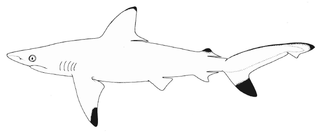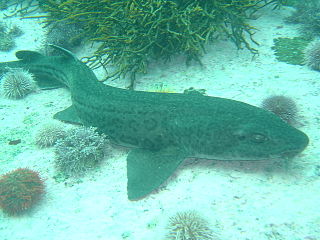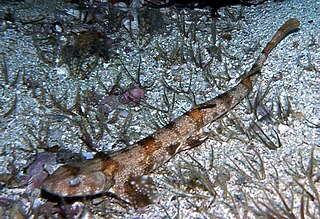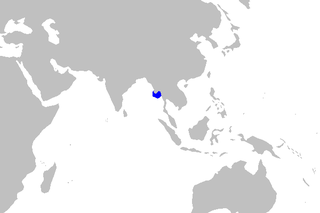
Requiem sharks are sharks of the family Carcharhinidae in the order Carcharhiniformes. They are migratory, live-bearing sharks of warm seas and include such species as the tiger shark, bull shark, lemon shark, spinner shark, blacknose shark, blacktip shark, grey reef shark, blacktip reef shark, silky shark, dusky shark, blue shark, copper shark, oceanic whitetip shark, and whitetip reef shark.

Carpet sharks are sharks classified in the order Orectolobiformes. Sometimes the common name "carpet shark" is used interchangeably with "wobbegong", which is the common name of sharks in the family Orectolobidae. Carpet sharks have five gill slits, two spineless dorsal fins, and a small mouth that does not extend past the eyes. Many species have barbels.

The whitespotted bamboo shark is a carpet shark with an adult size that approaches one metre in length. This small, mostly nocturnal species is harmless to humans. The whitespotted bamboo shark is occasionally kept as a pet in larger home aquaria. It can grow up to 93 centimetres (37 in) long.

The speartooth shark is a rare species of river shark, belonging to the family Carcharhinidae. It inhabits coastal marine waters and tidal reaches of large tropical rivers in northern Australia and New Guinea. Despite being a member of the river shark genus, it is also found in near-shore marine waters, favoring highly turbid environments over a wide range of salinities. This robustly built, gray-colored shark is characterized by a short and broad snout, tiny eyes, a relatively large second dorsal fin, and a black blotch beneath each pectoral fin near the tip. Another identifying trait is its teeth, which are large, triangular, and serrated in the upper jaw and narrow, spear-like, and serrated only near the tips in the lower jaw. Adults grow to about 2.6 m (8.5 ft) long.

The Pondicherry shark is an extremely rare species of requiem shark, in the family Carcharhinidae. A small and stocky gray shark, it grows not much longer than 1 m (3.3 ft) and has a fairly long, pointed snout. This species can be identified by the shape of its upper teeth, which are strongly serrated near the base and smooth-edged near the tip, and by its first dorsal fin, which is large with a long free rear tip. Furthermore, this shark has prominent black tips on its pectoral fins, second dorsal fin, and caudal fin lower lobe.

The spot-tail shark, or sorrah shark, is a species of requiem shark, in the family Carcharhinidae, found in the tropical Indo-West Pacific Ocean between latitudes 31°N and 31°S, from the surface to a depth around 72 m (236 ft). This shark grows to about 1.6 m. It is fished commercially over much of its range and the IUCN considers it to be near threatened.

The Hemiscylliidae are a family of sharks in the order Orectolobiformes, commonly known as longtail carpet sharks and sometimes as bamboo sharks. They are found in shallow waters of the tropical Indo-Pacific.

The leopard catshark is a species of catshark, and part of the family Scyliorhinidae, endemic to the coastal waters of South Africa. Abundant in inshore waters under 20 m (66 ft) deep, this bottom-dweller favors rocky reefs, kelp beds, and sandy flats. Growing to a length of 84 cm (33 in), the leopard catshark has a stout body with two dorsal fins placed well back, and a short head and tail. It is extremely variable in color and pattern, with individuals ranging from almost white to black and covered by diverse patterns of black spots, blotches, rosettes, and/or lines. The color pattern changes with age and some forms seem to be location-specific, suggesting the presence of multiple distinct, local populations. In the past, some of the more distinct color forms have been described as different species.

Haploblepharus is a genus of catshark, and part of the family Scyliorhinidae, containing four species of shysharks. Their common name comes from a distinctive defensive behavior in which the shark curls into a circle and covers its eyes with its tail. The genus is endemic to southern Africa, inhabiting shallow coastal waters. All four species are small, stout-bodied sharks with broad, flattened heads and rounded snouts. They are characterized by very large nostrils with enlarged, triangular flaps of skin that reach the mouth, and deep grooves between the nostrils and the mouth. Shysharks are bottom-dwelling predators of bony fishes and invertebrates. They are oviparous, with the females laying egg capsules. These harmless sharks are of no commercial or recreational interest, though their highly limited distributions in heavily fished South African waters are of potential conservation concern.

The banded houndshark is a species of houndshark in the family Triakidae, common in the northwestern Pacific Ocean from the southern Russian Far East to Taiwan. Found on or near the bottom, it favors shallow coastal habitats with sandy or vegetated bottoms, and also enters brackish water. This shark reaches 1.5 m (4.9 ft) in length. It has a short, rounded snout and mostly narrow fins; the pectoral fins are broad and triangular, and the trailing margin of the first dorsal fin is almost vertical. It is gray above and lighter below; younger sharks have darker saddles and dots, which fade with age.

The dark shyshark or pretty happy is a species of catshark, belonging to the family Scyliorhinidae, endemic to the temperate waters off southern Namibia and western South Africa. It is benthic in nature and inhabits shallow, inshore waters and favors rocky reefs and kelp forests. Growing to 60 cm (24 in) long, this small, stocky shark has a wide, flattened head with a rounded snout and a large flap of skin extending from before the nostrils to the mouth. Its dorsal coloration is extremely variable and may feature black-edged orange to blackish saddles and/or white spots on a light brown to nearly black background.

The brownbanded bamboo shark, is a bamboo shark in the family Hemiscylliidae that can be found in the Indo-West Pacific from Japan to northern Australia, between latitudes 34° N and 26° S. It is regularly bred in public aquaria, and is arguably one of the sharks most suited to captivity due to its docile disposition, sedentary nature, and relatively small size. In public aquariums, these fish can live up to 25 years.

The slender bamboo shark, Chiloscyllium indicum, is a bamboo shark in the family Hemiscylliidae found in the Indo-West Pacific Oceans between latitudes 40° N and 10° S, and longitude 65° E and 160° E. It is harmless to humans.

The Arabian carpetshark is a species of carpet shark in the family Hemiscylliidae, inhabiting coral reefs and other shallow coastal habitats from the Persian Gulf to India. Reaching 78 cm (31 in) long, this shark is characterized by a slender, plain brown body, and by two dorsal fins with straight trailing margins and the second smaller but longer-based than the first. The Arabian carpetshark feeds on bony fishes and invertebrates. Reproduction is oviparous with an annual cycle; females deposit egg capsules four at a time and the young hatch after 70–80 days. This small shark is often captured as bycatch but rarely used by humans. It has been assessed as Near Threatened by the International Union for Conservation of Nature (IUCN), as there is increasing fishing pressure and habitat degradation within its range. It does well in aquariums and has been bred in captivity.

The Burmese bamboo shark, Chiloscyllium burmensis, is an extremely rare bamboo shark in the family Hemiscylliidae. The first specimen was caught 1963 off the coast from Rangoon in Burma in a depth of 29 – 33 m. This holotype is an adult male, 57 cm long and kept in the National Museum of Natural History, Smithsonian Institution, Washington DC. Later, three more specimens, two males and one female, were recorded 2018 from the Bangladesh Fisheries Development Corporation Fish Landing Center of Cox’s Bazar.
The New Ireland stingaree or black-spotted stingaree, is a species of stingray in the family Urolophidae, known only from a single juvenile male 17.4 cm (6.9 in) long, collected in the Bismarck Archipelago. This species has an oval pectoral fin disc with tiny eyes and a rectangular curtain of skin between the nostrils. Its tail is fairly long and terminates in a leaf-shaped caudal fin, and lacks a dorsal fin. Uniquely among stingarees, it has rows of sharp spinules on the posterior portion of its back and the base of its tail. Its dorsal coloration is brown with dark spots. The International Union for Conservation of Nature (IUCN) has listed this ray as Data Deficient, pending more information.

Hemiscyllium is a genus of sharks in the family Hemiscylliidae.

Galeomorphii is a superorder of cartilaginous fishes which includes all modern sharks except the dogfish and its relatives. They are sometimes called galea or galean sharks. There are about 300 living species in 23 families. Galean sharks are divided into four orders: the Heterodontiformes, Orectolobiformes, Lamniformes, and Carcharhiniformes

















